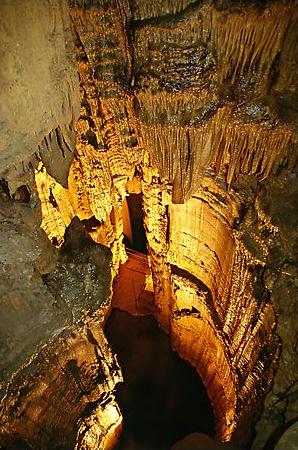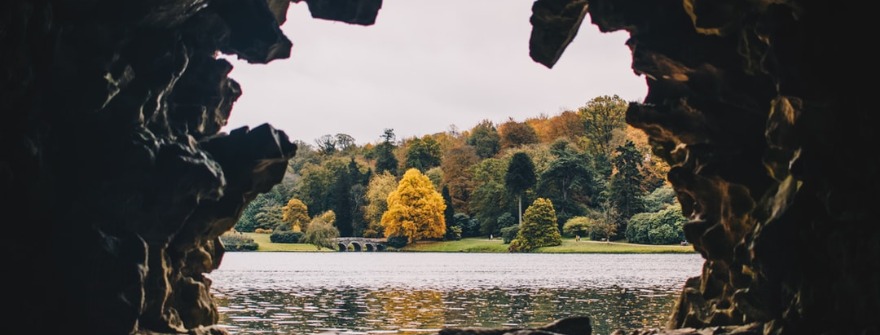Mammoth Cave National Park Visitors Guide
As a national park, World Heritage Site, and International Biosphere Reserve, Mammoth Cave is recognized worldwide as a unique and exemplary karst resource. Beneath the surface is the longest cave known to man. It extends at least 365 miles, with more discovered every year. Above the surface lie steep hills and valleys, winding rivers and woodlands re-grown from the farms and small communities that existed here before the park’s establishment in 1941.
The three hundred and fifty miles of labyrinthine passages and domed caverns of Mammoth Cave National Park lie halfway between Louisville and Bowling Green. Its amazing geological formations, carved by acidic water trickling down through limestone, include a bewildering display of stalagmites and stalactites. Other features include a huge cascade of flowstone called Frozen Niagara and Echo River, 365 ft below ground.

Mammoth Cave was designated as a World Heritage Site in 1981 and as an International Biosphere Reserve in 1990. Among traces of human occupation here are Native American artifacts, a former saltpeter mine, and the remains of an experimental tuberculosis hospital, built in 1843. Access is by guided tours; tickets are available at the visitor center. Keep in mind the temperature in the caves is a constant 54 F, so take a sweater or jacket.
All the park’s attractions are not subterranean. The scenic Green River cuts through densely forested hillsides and limestone cliffs; you can follow hiking trails, rent canoes or, for a more leisurely trip, take the Miss Green River cruise boat. Camping is free in the backcountry; however, a permit must be picked up first at the visitor center. The privately ignored caves all around are best ignored.
If you have spare time, you might want to visit the nearby town of Bowling Green. It’s a lively place and offers a treat for sports car fans. One hour tours of the General Motors Corvette Assembly Plant take a step-by-step look at the manufacture of one of the great symbols of America.
Mammoth Cave National Park was established to preserve the cave system, including Mammoth Cave, the scenic river valleys of the Green and Nolin rivers, and a section of south-central Kentucky. This is the longest recorded cave system in the world with more than 336 miles explored and mapped.
Mammoth Cave Trivia
- 138 species make use of the cave on a regular basis – 42 of these are troglobites, adapted exclusively to life in the cave. Blind fish, crayfish and the Kentucky cave shrimp are eyeless and colorless.
- Prehistoric people scraped minerals from the cave walls between 2,000 and 4,000 years ago and left behind slippers, gourds, and torch sticks that are perfectly preserved in the cave’s constant environment.
- In 1838, three young slaves were leased to the owner of Mammoth Cave to guide the visiting public into the cavern. Nick Bransford, Mat Bransford, and Stephen Bishop became well-known personalities and discovered many of the passageways still shown on tours today.
Mammoth Cave Attractions
- Cave tours are offered year-round, ranging from an easy ¼-mile stroll to 5 miles of crawling, climbing, and sliming. Blackouts in the cave’s total darkness, when guides purposely turn off all the lights, are a favorite memory of returning visitors.
- Enjoy a quiet hike in the 300-acre Big Woods, an old-growth remnant on the north side of Green River.
- Take a twilight stroll around the Sloan’s Crossing Pond Walk to the riotous croak-buzz-and-squawk of frogs, bugs, and water birds.
Designations
National Park – July 1, 1941
World Heritage Site – October 27, 1981
International Biosphere Reserve – September 26, 1990
Operating Hours, Seasons
Schedule varies by season. Call for current information. Closed December 25.
As a national park, World Heritage Site, and International Biosphere Reserve, Mammoth Cave is recognized worldwide as a unique and exemplary karst resource. Beneath the surface is the longest cave known to man. It extends at least 365 miles, with more discovered every year. Above the surface lie steep hills and valleys, winding rivers and woodlands re-grown from the farms and small communities that existed here before the park’s establishment in 1941.
Getting There
PLANE – Regular flights into Louisville or Nashville, each approx. 1.5 hours from the park.
CAR – If you travel south from Louisville, KY, the most direct route is I-65 south to Exit 53 at Cave City. Another 15 minutes of driving will bring you to the park visitor center.
If you travel north from Nashville, TN, the most direct route is I-65 north to Exit 48 at Park City, KY. Another 10 minutes of driving will bring you to the park visitor center. Nashville and the park are both in the Central Time Zone. Louisville is in the Eastern Time Zone, one hour ahead of the park.
PUBLIC TRANSPORTATION – Bus service stops in Cave City, KY.
Weather & Climate
Summers are hot and sultry with highs in the 80s to 90s. Winters are mild with highs in the 30s to 40s, although temperatures can drop well below zero. Temperatures in the cave hover around 54°F year-round, so bring a light jacket if you plan to visit the cave.
Accessibility
Sloan’s Crossing Pond Trail; Heritage Trail; Evening Programs; auditorium programs
Getting Around
You may travel by car to most places in the park. In the backcountry, you may hike, ride horseback, and in limited areas, ride a mountain bike. You may canoe down 27 miles of the Green and Nolin Rivers.
